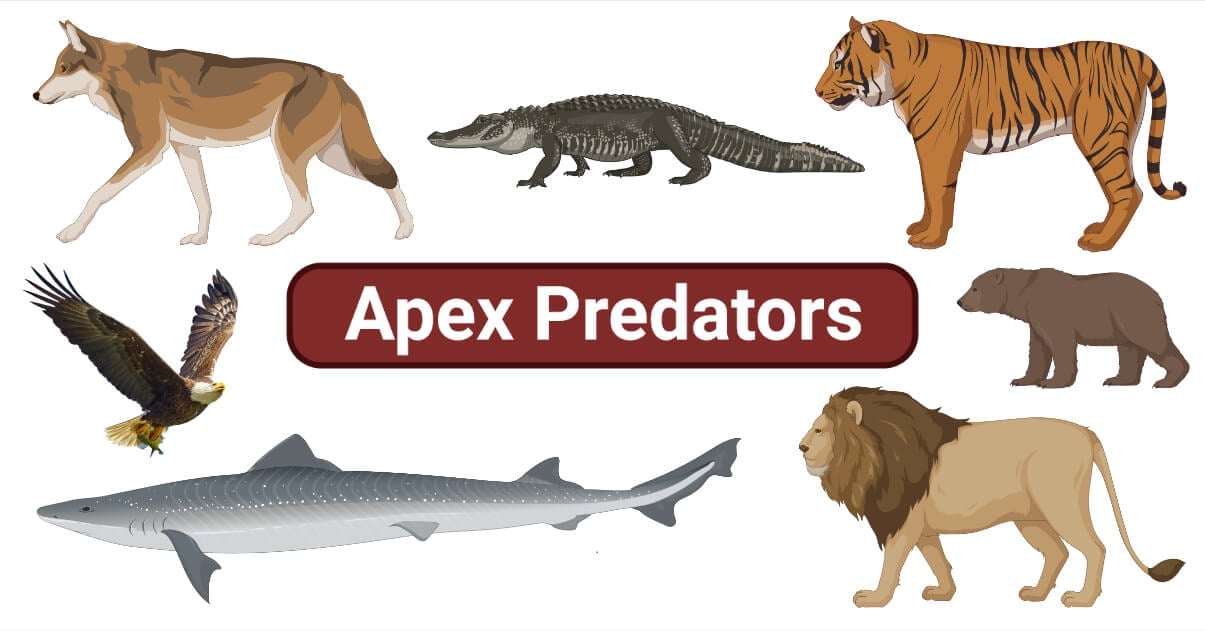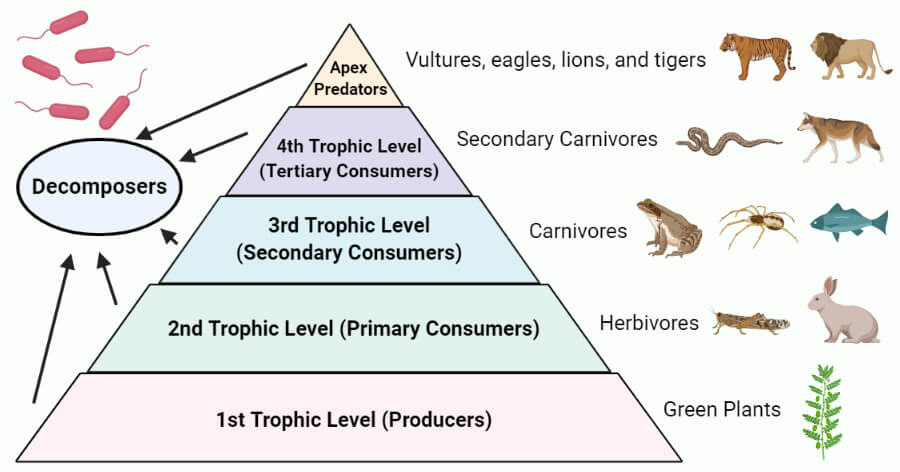Apex predators are commonly referred to as the top predators in the ecological food chain. They bear the top-most rank in the herbivore-carnivore food chain, lacking any natural enemy or predator.
These flesh-eating animals occupy the uppermost spot Trophic Energy Pyramid of the Ecosystem, marking the last destination for the energy flow in any given biological community. Their influence greatly impacts population dynamics and the biodiversity of prey species and fellow predators in the ecological community. They also participate in regulating the disease of the general population.
Apex predators flourish in both terrestrial and aquatic environments. Some examples of apex predator species in the terrestrial environment include the largest member of the Felidae (cat) family such as Puma concolor (Puma), Panthera leo (Lion), Panthera tigris (Tiger) and others; birds of prey like vultures, condor, etc.

Ecological traits such as reproductive rates, population territory, infanticide, prey density, etc., profoundly impact these predators. Large carnivores weighing above 34 kg show slow reproduction rates, extended parental care to the offspring, and sparsely distributed populations. In contrast, the smaller carnivores have faster reproduction rates, thus leading to higher population density in the ecosystem. Self-regulation and prey dynamics play a significant role in the conservation of resources for these apex predators to flourish and balance the surrounding ecosystem.
Interesting Science Videos
Trophic Cascade Theory and Apex Predators
There have been several attempts to come up with a proper definition for the term trophic cascade and its theory. Still, it refers to ‘the interaction of different intermediary species via an indirect manner, spreading downward in a top-down forcing through food web that originated with predators.’ This definition confers the ‘consumptive effects’ of trophic cascades, or the predators would have starved, leading to extensive population growth as preys have no predation risk. Thus the emphasis of trophic cascades beginning with higher trophic level species and spreads downward to fulfill the necessary balance of energy flow in the ecosystem.

Consider the example of the top-down forcing trophic cascade of grey wolves’ impact on herbivore ‘elk’ (Cervus elaphus), to significantly influence berry-producing shrubs consumed by the grizzly bears (Ursus arctos). This depicts the trophic cascade event that started with the apex predator, the grey wolf, and its influence through the food web, affecting the prey dynamics and plant species in that locality. Remarks by Darwin, ‘t the presence of a feline animal in large numbers in a district might determine, through the intervention first of mice and then of bees, the frequency of certain flowers in that district.
Ecological Effect of Trophic Cascade
- Due to globalization, we see a shift in the species introduction and distribution into a new area which led to alarming concern among the biologist and conservation managers regarding the decrease and extinction of native species.
- The repatriation of apex predators shifts and influences the non-native ecologies and enhances the coexistence of native-non-native contexts.
- Thus, we can conclude that trophic cascades regulate the species’ population and composition and biomass distribution and influence the growth of herbivores and plant species in the terrestrial and aquatic environments.
Demerits of Native-Non-native Dichotomy
- There seems to be more concern among conservationists that the control efforts of introducing new species to an area do not promise to restore native communities or limit non-native species because controlled efforts require more interventions.
- For instance, eradicating ‘Felis catus’ (non-native cats) from the offshore islands of New Zealand and Australia led to the intrusion of non-native rats (Rattus exulans) and rabbits (Oryctolagus cuniculus) that harm the native flora and bird populations.
- Though it is believed that introducing non-native species has a beneficial ecological effect and enhanced biodiversity, they even substitute for the ecological aid deficit due to the extinct native population.
- And the role of Apex Predators as biodiversity environmental drivers has a huge influence on the native-non-native dichotomy.
Keystone Species as Apex Predators
An ecosystem comprises animals, plants, and many other factors, and the complex intermediary species constitute a unique environment. Every ecosystem has an extreme species population that, at a glance, should not belong to one ecosystem, but they do, and that is possible due to the presence of keystone species. They are an important link for the survival of other species in the surroundings.
- They can be an apex predator or simple plants, but without their interference, an ecosystem would not thrive. They help glue the ecosystem together, or else the system would not be able to adapt to the changing environment.
- Eventually, the ecosystem would collapse in their absence. Apex predators disguising as a keystone species, help regulate the population of other predator and prey species, hence affecting the quantity and distribution of animals and plants down the food web in an ecosystem.
- Tiger sharks can be seen as keystone species in the Australian marine ecosystem. Their presence near the seagrass bed declines the sea turtles from overgrazing grass beds, making them graze across a much wider region. Tiger sharks are also observed to feed upon sick fish, helping other marine animals to flourish.
Conservation of Apex Predators
There isn’t one approach for conserving large predators that suits all. Many factors, such as environmental conditions, native species of flora and fauna, human invasion, etc., play a key role in wildlife conservation. Some conservationists believe the ‘top-down approach’ to be the most effective, while others favor the ‘collaborative approach’. Countries like USA and Europe have dedicated legislation and resources for a ‘top-down conservation approach’ with appropriate legitimate interventions. As for developing nations, collaborative or native-non-native approaches are significant in carnivore conservation. Coercive policies by the government can lead to non-compliance and a decline in political legitimacy. In contrast, the collaborative approach builds trust and improves learning and social outcomes.
Conservation Legislation
The legislation provides a strong and supportive framework for modulating the relationship between predators and people and addresses the conservation-related conflicts concerned with shared landscapes at local and intergovernmental levels. Many large national and international legal bodies have come together to present a functional legal approach for predator conservation and restore the ecological balance, among other interests.
In the United States, the state government handles more of the power for wildlife management and conservation as a public trust.
- And the Federal Government holds the power to manage wildlife in important matters under the ESA (Endangered Species Act) whenever any animal faces the issue of endangerment or extinction.
- Once the species recover, the wildlife preservation management is returned to the state government.
- ESA faces many issues from the local authorities as it prohibits considering the economic management of wildlife.
Habitat Directive is the principal management body for wildlife conservation in the European Union. Any species that are listed by the Directive’s aim to achieve ‘FCS’ (Favourable Conservation Status).
- Member states of the Directive solely consider wildlife conservation’s social, economic, and cultural requirements.
- The policies of the FCS enforce a strict protection regime and non-negotiable control management.
- However, if the predator population is rising and there is a positive shift in the ecosystem, the rules can become flexible per the requirement.
It is observed that Developing nations face the most challenges in predator conservation and management.
- Wildlife conservation is often considered low on the agenda due to other competing pressures, such as poverty, hunger, etc., faced by developing nations.
- The poor management of limited resources and corrupt governance led to inadequate handling of wildlife land and their population outside protected areas.
Collaborative Approach
Ansell and Gash published an article, ‘Collaborative Governance in Theory and Practice’ in 2008, which defined this approach as an ‘arrangement where one or more public agencies directly engage non-state stakeholders in a collective decision-making process that is formal, consensus-oriented and deliberative and that aims to make or implement public policy or manage public programs or assets’. This approach is particularly beneficial for predator management in wildlife. The principal task of the group participating in the collaboration includes adopting and developing management plans, determining local population goals, diminishing any conflict between wildlife and livestock resources, and fixing a quota for large carnivore predators. This approach builds trust, strengthens democracy, and mitigates problems arising due to governance and acceptance of the central management system of large carnivore predators.
Apex Predators and Ecotourism
Conservation of Apex predators through the integration of tourism has been the best approach to this agenda. Ecotourism shows great potential in predator-focused wildlife conservation. This type of conservation is practical for studying the social, behavioral, and biological activities of predators in a confined environment. An additional concern about human safety and their interaction with wild animals increases the complexity of this approach.
Conditions to be fulfilled to develop an ecosystem for large carnivore wildlife tourism are:
- Strict and effective legal protection laws provided for wildlife and its habitat.
- Protected areas should be devoid of human intervention and distant from regions with dense populations.
- Tourism programs and management must be of high-quality interpretation.
- Consultation and involvement of local authorities in program development and implementation.
- Funds from stakeholders can compensate for local bodies’ losses and opportunity costs.
Conclusion
Apex Predators are an important ecological component occupying the top-most trophic level with no natural predator. They are environmental drivers that significantly impact all aspects of their surroundings, from controlling the dynamics of prey species and other predators to driving the ecological balance. They are an important contributor to any ecosystem. They face an issue of extinction due to many factors, such as climate change, invasion of other predators, and availability of prey species and their populations and many other factors. Hence, their conservation and protection is a top priority in any nation for wildlife management.
References
- Wallach, Arian D., et al. “What is an apex predator?.” Oikos 124.11 (2015): 1453-1461.
- Wallach, Arian D., William J. Ripple, and Scott P. Carroll. “Novel trophic cascades: apex predators enable coexistence.” Trends in Ecology & Evolution 30.3 (2015): 146-153.
- apex predator – https://www.britannica.com/science/apex-predator
- APEX PREDATOR ANIMALS – https://animalia.bio/apex-predator?page=1
- Ripple, William J., et al. “What is a trophic cascade?.” Trends in ecology & evolution 31.11 (2016): 842-849.
- trophic cascade – https://www.britannica.com/science/trophic-cascade
- Keystone Species – https://education.nationalgeographic.org/resource/keystone-species
- Redpath, Steve M., et al. “Don’t forget to look down–collaborative approaches to predator conservation.” Biological Reviews 92.4 (2017): 2157-2163.
- Ansell, Chris, and Alison Gash. “Collaborative governance in theory and practice.” Journal of public administration research and theory 18.4 (2008): 543-571.
- Macdonald, Catherine, et al. “Conservation potential of apex predator tourism.” Biological Conservation 215 (2017): 132-141.
